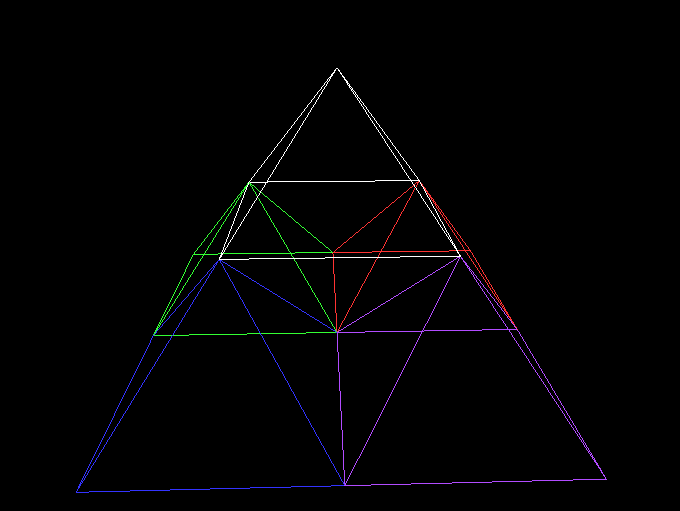This is a small OpenGL program that renders uses an L-system and turtle graphics to draw 3D fractals.
(It looks better in motion!)
Building this requires gcc to be installed and available on your path, and
for GLFW to be installed.
Edit the Makefile to replace the GLFW_DIR variable with the path where GLFW
is installed on your system. Alternatively, set the GLFW_DIR environment
variable. Afterwards run make to compile the program.
Edit build_windows.bat and replace any occurrences of C:\bin\glfw-3.3.3\
with the path where GLFW is installed on your system. Afterwards, run
build_windows.bat to compile the program.
Run ./l_system_3d (or l_system_3d.exe on Windows). A window should appear
displaying an L-system rendering. This can be controlled using some simple
keypresses:
-
Increase iterations by 1: Press the "up" arrow key.
-
Decrease iterations by 1: Press the "down" arrow key.
-
Reload the config file: Press the "R" key.
-
Switch between rendering modes: Press the "M" key.
-
Quit the program: Close the window, or press the escape key.
The system reads its configuration from the "config.txt" file by default. If desired, you can pass a path to a different config as the program's first (and only) command line argument.
The config file must contain only ASCII characters. It starts with the L-system
definition (replacement rules). Following a line containing the keyword
actions, the file switches to defining the drawing actions the "turtle" takes
when encountering each character. (The actions line must occur exactly once
in the config.)
If you want a longer example, the default "config.txt" contains instructions
for drawing a multi-colored Sierpinski pyramid. A simpler, single, dragon-curve
example is also available in dragon_curve.txt. The contents of
dragon_curve.txt are copied here:
init F
F F+G
G F-G
actions
F
move_forward 1.0
G
move_forward 1.0
-
rotate -90.0
+
rotate 90.0
Any lines starting with # in the config file are ignored. So, in addition to
L-system characters being limited to ASCII, non-printing, whitespace
characters, and the # character are not allowed in replacement rules. Note
that the # must be the first non-whitespace character in the line.
The first part of the config defines the replacement rules. This section of
the file ends when the line containing the word actions is encountered.
Exactly one line in this part of the file must give the initial contents of the
L-system string:
init <initial text>
All other non-blank and non-comment lines in this section take the following format:
<character> <string of replacement characters>
The character is separated from the string of replacements by one or more tab or space characters.
Characters with no defined replacement rules are left as-is during L-system iteration. Any line containing a character with no following replacement text indicates that the character is to be deleted when encountered (i.e. replaced with a blank string).
Each character can have at most one replacement rule.
Following the actions line, the config switches to defining what each
character means for drawing the graphics. Actions for a character are defined
as follows:
<character>
<action 1>
<action 2>
...
<action n>
In other words, the character must first appear on a line by itself. The following lines must contain the arbitrary number of actions to be taken when the character is processed. The list of actions ends when either the end of the file is reached or another line containing a single character is reached. (Note that none of the actions are a single character long, so there is no ambiguity between lines containing a single character and lines containing an action.)
Each character is allowed at most one associated sequence of actions. Any character that does not appear in the actions section prompts no drawing actions when rendering the L-system. (This can also be achieved by including a character in the actions section, but not specifying any actions after it.)
The following list of actions are supported:
-
move_forward <distance>: Moves the turtle forward the given distance, and draws the line segment along its path. The distance is a floating-point number of units. Units are not particularly relevant, because the resulting 3D rendering will be scaled to fit in the viewport regardless. -
rotate <degrees>: Rotates the turtle to its left by the given floating-point number of degrees. -
yaw <degrees>: The same as therotateaction. -
pitch <degrees>: Rotates the turtle in the upwards direction by the given floating-point number of degrees. -
roll <degrees>: Rotates the turtle by the given number of degrees about its forward-facing axis. -
move_forward_nodraw <distance>: Likemove_forward, but does not draw a line segment. -
set_color_r <value>: Sets the turtle's red color channel to the given value. The value will be clamped to be between 0.0 and 1.0. -
set_color_g <value>: The same asset_color_r, but for the green channel. -
set_color_b <value>: The same asset_color_r, but for the blue channel. -
set_color_a <value>: The same asset_color_r, but for the alpha channel. -
push_position 0.0: Pushes the turtle's current position onto a stack of positions, so that it can be restored later. The "0.0" is ignored, but required to simplify internal config-parsing logic. -
pop_position 0.0: Restores the turtle's current position from whichever position is on top of the stack. Removes the position on top of the stack. It is an error to encounter this instruction if the stack is already empty. Once again, the "0.0" argument is ignored, but required in the config. -
push_color 0.0: Analogous topush_position, but saves the turtle's current color on a stack. -
pop_color 0.0: Analogous topop_position, but restores the last color pushed bypush_color.
Prior to taking any actions, the turtle is initialized at position (0, 0, 0), facing in the positive-X direction, with its pitch and roll set so that its "back" is facing upwards; in the positive-Y direction.
